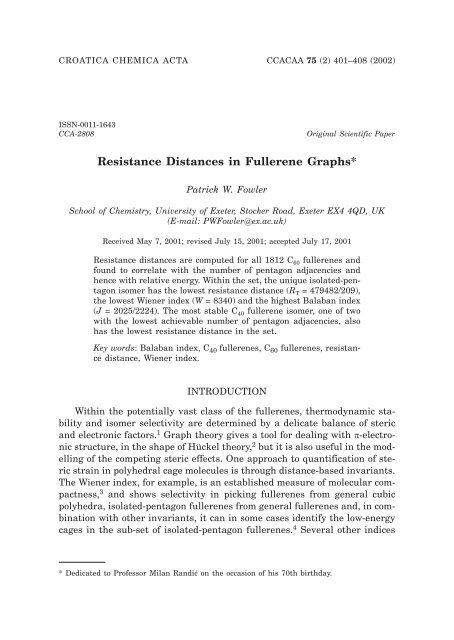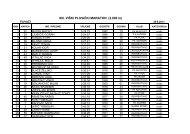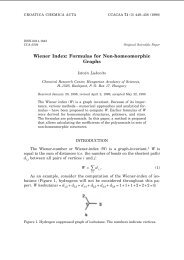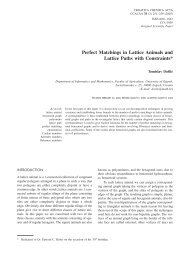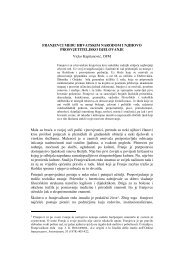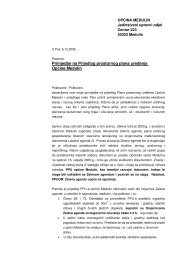Resistance Distances in Fullerene Graphs*
Resistance Distances in Fullerene Graphs*
Resistance Distances in Fullerene Graphs*
Create successful ePaper yourself
Turn your PDF publications into a flip-book with our unique Google optimized e-Paper software.
CROATICA CHEMICA ACTA CCACAA 75 (2) 401¿408 (2002)ISSN-0011-1643CCA-2808Orig<strong>in</strong>al Scientific Paper<strong>Resistance</strong> <strong>Distances</strong> <strong>in</strong> <strong>Fullerene</strong> <strong>Graphs*</strong>Patrick W. FowlerSchool of Chemistry, University of Exeter, Stocker Road, Exeter EX4 4QD, UK(E-mail: PWFowler@ex.ac.uk)Received May 7, 2001; revised July 15, 2001; accepted July 17, 2001<strong>Resistance</strong> distances are computed for all 1812 C 60 fullerenes andfound to correlate with the number of pentagon adjacencies andhence with relative energy. With<strong>in</strong> the set, the unique isolated-pentagonisomer has the lowest resistance distance (R T = 479482/209),the lowest Wiener <strong>in</strong>dex (W = 8340) and the highest Balaban <strong>in</strong>dex(J = 2025/2224). The most stable C 40 fullerene isomer, one of twowith the lowest achievable number of pentagon adjacencies, alsohas the lowest resistance distance <strong>in</strong> the set.Key words: Balaban <strong>in</strong>dex, C 40 fullerenes, C 60 fullerenes, resistancedistance, Wiener <strong>in</strong>dex.INTRODUCTIONWith<strong>in</strong> the potentially vast class of the fullerenes, thermodynamic stabilityand isomer selectivity are determ<strong>in</strong>ed by a delicate balance of stericand electronic factors. 1 Graph theory gives a tool for deal<strong>in</strong>g with -electronicstructure, <strong>in</strong> the shape of Hückel theory, 2 but it is also useful <strong>in</strong> the modell<strong>in</strong>gof the compet<strong>in</strong>g steric effects. One approach to quantification of stericstra<strong>in</strong> <strong>in</strong> polyhedral cage molecules is through distance-based <strong>in</strong>variants.The Wiener <strong>in</strong>dex, for example, is an established measure of molecular compactness,3 and shows selectivity <strong>in</strong> pick<strong>in</strong>g fullerenes from general cubicpolyhedra, isolated-pentagon fullerenes from general fullerenes and, <strong>in</strong> comb<strong>in</strong>ationwith other <strong>in</strong>variants, it can <strong>in</strong> some cases identify the low-energycages <strong>in</strong> the sub-set of isolated-pentagon fullerenes. 4 Several other <strong>in</strong>dices* Dedicated to Professor Milan Randi} on the occasion of his 70th birthday.
402 P. W. FOWLERhave similar characteristics, and there are many distance-related <strong>in</strong>variants<strong>in</strong> the literature of chemical graph theory.Recently, resistance distances 5 have been calculated for Platonic polyhedra6,7 <strong>in</strong> an algebraic treatment that was described as present<strong>in</strong>g some difficultyfor the dodecahedron. 7 Numerical solution of the problem is straightforward,and is applied here to a representative sample set of fullerenes, the1812 isomers of C 60 , to compare the extremal properties of resistance distancewith those of other distance-related <strong>in</strong>dices. It is found that the uniquetruncated icosahedral isomer, the experimental C 60 molecule, is extremal<strong>in</strong> this property, as it is <strong>in</strong> the Wiener and Balaban <strong>in</strong>dices, and is <strong>in</strong>fact the isomer with the lowest resistance distance of all the cages that canbe assembled from 12 pentagonal and 20 hexagonal faces. A previous studyconcentrated on the relative abilities of these and other <strong>in</strong>dices to characteriseC 60 fullerenes. 8 The focus here is on the ability of the resistance distanceto reflect the physically and chemically important energetics of thefullerenes. In this context, the multiplicity of an <strong>in</strong>dex value is less importantthan its extremal properties.METHODThe concept of resistance distance of a graph is based on an electricalanalogy. 5 Each edge of the graph is taken to be a wire of unit resistance, andpairs of vertices are treated as term<strong>in</strong>als across which there is an appliedpotential drop. Unit current is assumed to flow <strong>in</strong> at one term<strong>in</strong>al and out atthe other. For each choice of a pair of term<strong>in</strong>al vertices, bond currents arecalculated over the whole graph by application of Kirchhoff's laws, 9 and theresistance between the term<strong>in</strong>als follows from the sum of bond currentstaken along any route from one to the other. Summation of the calculatedresistance over all dist<strong>in</strong>ct choices of the term<strong>in</strong>al pair gives the total resistancedistance R T (G) of the graph G. 5,7If resistance is regarded as a metric def<strong>in</strong><strong>in</strong>g a separation ij for eachpair of vertices i and j of G, then R T (G) is the half sum of all the entries, relatedto the matrix W <strong>in</strong> the same way that W, the Wiener Index, derivesfrom the ord<strong>in</strong>ary distance matrix D. To emphasise this similarity, R T (G) issometimes called the Kirchhoff Index, Kf. 9 In an acyclic graph Wiener andKirchhoff <strong>in</strong>dices are equal; <strong>in</strong> a general graph Kf is equal to the quasi-Wiener<strong>in</strong>dex. 10,11If the vertices are labelled 1 to n, each edge vector is given a positivesense <strong>in</strong> the direction from lower to higher vertex label. Bond currents arethen scalar multiples (positive or negative) of the bond vectors , descri-
RESISTANCE DISTANCES IN FULLERENE 403bed by coefficients c ij . Kirchhoff's first and second laws give the currentsums at the vertices:n A'ijj 1c ij =+1 (i = <strong>in</strong>put term<strong>in</strong>al)=–1 (i = output term<strong>in</strong>al) (1)= 0 (otherwise)where A' is a signed adjacency matrix with elements A' ij= +1 for neighboursj > i, A' ij= –1 for neighbours j < i, and A' ij= 0 otherwise. Similarly, for the cyclesi 1 i 2 i 3 ... i r ,A'iic + A1 2 ii'1 2 i ic2 3 i i+ ... + A '2 3 ir i1c i r i=0. (2)1A cubic polyhedron such as a fullerene has n vertex conditions of type (1)and (n/2+2) face-cycle conditions of type (2), of which (n–1) and (n/2+1), respectively,can be taken as <strong>in</strong>dependent <strong>in</strong> the absence of symmetry. Aga<strong>in</strong><strong>in</strong> the absence of symmetry considerations, there are n(n–1)/2 dist<strong>in</strong>ct choicesof term<strong>in</strong>al pairs, and the patterns of current are determ<strong>in</strong>ed by the l<strong>in</strong>earmatrix equationB × C = D (3)(n–1) + (n/2 +1) ×3n/2 3n/2 × n(n–1)/2 3n/2 × n(n–1)/2where B conta<strong>in</strong>s the various A' entries of the LHS of (1) and (2), C is thematrix of n(n–1)/2 column vectors c of scalar current coefficients, and D is arectangular array of the RHS of (1) and (2), with one column for each choiceof term<strong>in</strong>al pair. Symmetry can be used to reduce both the dimensions of cand the number of columns <strong>in</strong> D, but as most fullerenes have no symmetry,and the dimensions of the equations are <strong>in</strong> any case easily manageable forC 60 , no further manipulation of (3) is used here. The <strong>in</strong>version of B is convenientlyperformed for these small cases us<strong>in</strong>g Gauss-Jordan elim<strong>in</strong>ation, forwhich standard subrout<strong>in</strong>es are available. 12 The program was tested for thedodecahedron, and reproduced the results of Ref. 7.RESULTSAll quantities needed for the solution of (3) follow from the face-spiralencod<strong>in</strong>g of the adjacency <strong>in</strong>formation for fullerene isomers. 1,13 The 1812isomer datasets were constructed and processed to produce patterns of currentsfor each of the 1770 pair<strong>in</strong>gs of term<strong>in</strong>als, the correspond<strong>in</strong>g pair
404 P. W. FOWLERresistances, and hence the total resistance distances for each isomer. Fulllists of other distance <strong>in</strong>variants are also available. 4The truncated icosahedral isomer 60:1812 has 23 dist<strong>in</strong>ct term<strong>in</strong>al pair<strong>in</strong>gs,equivalent to the number of derivatives C 60 X 2 , and these lead to 23 differentcontributions to R T (60:1812). Conversion of the high precision numericalresults to fractional form gives the total resistance distance for thisisomer as R T (60:1812) = 479482/209 (i.e. 2294.1722). The separate resistancesare shown <strong>in</strong> Table I, us<strong>in</strong>g the standard vertex-spiral number<strong>in</strong>g scheme14 for the atoms of C 60 , and the pattern of currents for the 1,2 pair<strong>in</strong>gacross one of the formal double bonds of the structure is illustrated <strong>in</strong> Figure1.TABLE IContribut<strong>in</strong>g resistances for the dist<strong>in</strong>ct pair<strong>in</strong>gs of term<strong>in</strong>al vertices <strong>in</strong>icosahedral C 60 fullerene. Each dist<strong>in</strong>ct pair 1,m <strong>in</strong> the IUPAC vertex-spiralnumber<strong>in</strong>g scheme 14 has a resistance R(m), which can be expressed as a fractioni(m)/25080 where i(m) is an <strong>in</strong>teger, contribut<strong>in</strong>g with multiplicity g to the totalresistance distance, R T (60:1812).m g R(m) = i(m)/(120 × 209)6 60 16273/25080 0.6488442 30 16778/25080 0.6689787 60 23234/25080 0.9263963 120 24749/25080 0.9868024 60 27274/25080 1.08748013 120 29359/25080 1.17061419 60 29864/25080 1.19075017 120 31488/25080 1.25550218 120 32519/25080 1.29661115 60 33133/25080 1.32109316 60 33835/25080 1.34908338 60 34405/25080 1.37181039 60 34843/25080 1.38927431 120 35369/25080 1.41024834 120 36048/25080 1.43732135 60 36704/25080 1.46347733 120 36769/25080 1.46606953 60 37534/25080 1.49657152 120 37859/25080 1.50953049 60 38054/25080 1.51730555 30 38438/25080 1.53261651 120 38503/25080 1.53520760 30 38760/25080 1.545455
RESISTANCE DISTANCES IN FULLERENE 405Figure 1. Bond currents <strong>in</strong> truncated-icosahedral C 60 for a pair of term<strong>in</strong>als spann<strong>in</strong>gthe hexagon-hexagon edge of the polyhedron. The standard IUPAC number<strong>in</strong>gscheme is used. 14 Arrows on the diagram show the direction of current flow; dottedl<strong>in</strong>es are graph edges with zero current. The non-zero currents are (<strong>in</strong> units of501610 –1 ): 33556 (1®2); 8302 (1®6, 1®9, 3®2, 12®2); 5951 (4®3, 6®5, 9®10,11®12); 5050 (5®4, 10®11); 2351 (6®7, 9®8, 14®3, 7®21, 8®24, 13®12, 15®14,30®13); 1624 (18®17, 19®18, 26®27, 27®28); 1427 (16®15, 21®20, 24®25,29®30); 987 (35®34, 38®37, 43®44, 46®47); 924 (21®22, 22®39, 23®42, 24®23,31®30, 32®15, 33®32, 48®31); 901 (17®4, 5®19, 10®26, 28®11); 723 (17®16,20®19, 25®26, 28®29); 704 (20®38, 25®43, 34®16, 47®29); 656 (36®35, 37®36,44®45, 45®46); 650 (53®52, 57®58); 644 (55®60); 641 (39®40, 40®54, 41®56,42®41, 49®48, 50®33, 51®50, 59®49); 331 (37®53, 44®57, 52®35, 58®46); 322(54®55, 56®55, 60®51, 60®59); 319 (52®51, 54®53, 56®57, 58®59); 283 (34®33,39®38, 42®43, 47®48).Several patterns emerge when all 1812 values of R T are considered. Thewhole set of isomers spans a range of 264.94 and the average over the distributionis 2320.08. As shown <strong>in</strong> Figure 2(a), R T correlates smoothly with N p ,the number of pentagon adjacencies <strong>in</strong> the fullerene polyhedron, which isknown to be a useful qualitative measure of relative energy <strong>in</strong> lower fullerenes.15 The isolated-pentagon isomer has, of course, N p = 0, and m<strong>in</strong>imumR T ; the isomer next <strong>in</strong> R T is also the C 60 fullerene with the smallest non-zeroN p (isomer 60:1809), which is related to the truncated icosahedron by a s<strong>in</strong>-
406 P. W. FOWLERa) b)Figure 2. Correlations between resistance distances and other graph theoretical<strong>in</strong>variants for the set of 1812 fullerene isomers of C 60 . (a) Scatter plot of R T aga<strong>in</strong>stN p , the number of pentagon adjacencies. (b) Scatter plot of R T aga<strong>in</strong>st W, the Wiener<strong>in</strong>dex. The isolated-pentagon isomer is denoted by the empty circle, other isomers bythe filled circles.Wgle Stone-Wales transformation. 16 The isomer of highest resistance distanceis the high-energy 1812:1, the cyl<strong>in</strong>der with hemi-dodecahedral caps, for whichN p = 20. This isomer has R T = 2559.1089 (to mach<strong>in</strong>e accuracy, 47105517/18407). The extreme values of Kf and W for 60:1 and 60:1812 have been reported,8 though <strong>in</strong> the case of the Kirchhoff <strong>in</strong>dex, multiplied by an unconventionalextra factor of two.Other distance <strong>in</strong>variants have been calculated for this set of fullerenes.4,8 Isomer 60:1812 has the lowest Wiener <strong>in</strong>dex, W, and the highest Balaban<strong>in</strong>dex, 17 J, <strong>in</strong> the set. Figure 2(b) shows that there is a strong correlation,isomer-by-isomer, between W and R T . The correlation between J andR T (not shown) is of similar quality, as W and J are strongly (<strong>in</strong>versely) correlated.4For C 60 , all three <strong>in</strong>variants pick out the icosahedral isomer, track<strong>in</strong>gboth the total energy and the number of pentagon adjacencies. For othernumbers of vertices, there are some <strong>in</strong>dications that R T will <strong>in</strong> fact have abetter performance than the other distance <strong>in</strong>variants as a predictor of energy.Table II shows W and R T for the 40 fullerene isomers of C 40 , all ofwhich necessarily have some adjacent pentagons. Isomer 40:38 is one of twowith the m<strong>in</strong>imal 10 pentagon adjacencies, and is predicted to be the C 40fullerene of lowest energy by many methods; 15 it turns out also to have thesmallest resistance distance, by a marg<strong>in</strong> of 1 part <strong>in</strong> 1000, whereas its Wie-
RESISTANCE DISTANCES IN FULLERENE 407TABLE IIComparison of Wiener <strong>in</strong>dex (W), resistance distance (R T ) and pentagonadjacency count (N p ) for fullerene isomers of C 40Isomer N p W R T Isomer N p W R T1 20 3035 955.1508 21 12 2992 925.65982 16 3008 936.8771 22 12 2995 924.51733 18 3018 944.0339 23 13 2993 926.37074 15 3001 931.9751 24 11 2994 922.71195 14 2997 931.1004 25 12 2996 924.08796 14 2999 929.6359 26 11 2996 922.12777 15 2998 930.1360 27 12 2996 923.25158 15 3002 932.5192 28 12 2993 924.06959 13 2995 926.8919 29 11 2993 921.868810 13 2995 926.8944 30 12 2994 923.031611 15 2997 929.3356 31 11 2995 921.363812 13 2997 925.8184 32 14 3004 927.286913 13 2998 926.7625 33 14 3004 927.941114 12 2995 924.1053 34 12 2997 923.133415 12 3001 923.7521 35 11 2999 922.060216 13 3001 924.6078 36 11 2997 921.352117 13 3000 924.1504 37 11 2995 921.491518 14 2999 926.3455 38 10 2994 920.267919 13 2998 924.3389 39 10 2990 921.303120 12 3000 925.7556 40 12 3000 921.4659ner <strong>in</strong>dex of 2994 is shared by 2 isomers and beaten by 6 others. The C 40 isomerof lowest Wiener Index is actually the other fullerene with 10 adjacencies,40:39, which quantum mechanical methods predict to be marg<strong>in</strong>allyless stable than 40:38. In this case, R T is perform<strong>in</strong>g better than both thevery robust pentagon-adjacency <strong>in</strong>dex, which would not decide between40:38 and 40:39 and the Wiener <strong>in</strong>dex which would plump for the wrong isomer.Further <strong>in</strong>vestigation of the resistance distance for large sets of fullerenesmay be worthwhile.REFERENCES1. P. W. Fowler and D. E. Manolopoulos, An Atlas of <strong>Fullerene</strong>s, Clarendon Press,Oxford, 1995.2. A. Streitwieser Jr., Molecular Orbital Theory for Organic Chemists, Wiley, NewYork, 1961.
408 P. W. FOWLER3. H. Wiener, J. Am. Chem. Soc. 69 (1947) 17–20 and 2636–2638.4. P. W. Fowler, G. Caporossi, and P. Hansen, J. Phys. Chem. A, 105 (2001) 6232–6242.5. D. J. Kle<strong>in</strong> and M. Randi}, J. Math. Chem. 12 (1993) 81–95.6. I. Lukovits, S. Nikoli}, and N. Tr<strong>in</strong>ajsti}, Int. J. Quant. Chem. 71 (1999) 217–255.7. I. Lukovits, S. Nikoli}, and N. Tr<strong>in</strong>ajsti}, Croat. Chem. Acta 73 (2000) 957–967.(In Table II of this reference, i 2 should be 19/60, not 29/60 as pr<strong>in</strong>ted.)8. A. T. Balaban, X. Liu, D. J. Kle<strong>in</strong>, D. Babi}, T. G. Schmalz, W. A. Seitz, and M.Randi}, J. Chem. Inf. Comp. Sci. 35 (1995) 396–404.9. G. Kirchhoff, Über die Auflösung der Gleichungen, auf welche man bei der Untersuchungder l<strong>in</strong>earen Vertheilunge der Galvanischer Ströme geführt wirt,Ann. d. Physik u. Chemie 72 (1847) 497-508. Extracts and a commentary on thispaper are given <strong>in</strong> N. L. Biggs, E. K. Lloyd, and R. J. Wilson, Graph Theory 1736–1936, Clarendon Press, Oxford, 1998, Chapter 8.10. B. Mohar, D. Babi}, and N. Tr<strong>in</strong>ajsti}, J. Chem Inf. Comp. Sci. 33 (1993) 153–154.11. I. Gutman and B. Mohar, J. Chem. Inf. Comp. Sci. 36 (1996) 982–985.12. W. H. Press, B. P. Flannery, S. A. Teukolsky, and W. T. Vetterl<strong>in</strong>g, Numerical Recipes;The Art of Scientific Comput<strong>in</strong>g, Cambridge University Press, Cambridge,1986. See for example, the rout<strong>in</strong>e GAUSS <strong>in</strong> Chapter 2.13. D. E. Manolopoulos, J. C. May, and S. E. Down, Chem. Phys. Lett. 181 (1991) 105–111.14. E. W. Godly and R. Taylor, <strong>Fullerene</strong> Sci. Tech. 5 (1997) 1667–1708.15. E. Albertazzi, C. Domene, P. W. Fowler, T. He<strong>in</strong>e, G. Seifert, C. Van Alsenoy, and F.Zerbetto, Phys. Chem. Chem. Phys. 1 (1999) 2913–2918.16. A. J. Stone and D. J. Wales, Chem. Phys. Lett. 128 (1986) 501–503.17. A. T. Balaban, Chem. Phys. Lett. 80 (1982) 399–404.SA@ETAKOtporne udaljenosti u fullerenskim grafovimaPatrick W. FowlerZa svih 1812 C 60 fulerena izra~unane su otporne udaljenosti i na|eno je da korelirajus brojem susjednih peterokuta i stoga s relativnom energijom. Unutar togaskupa, izomer s potpuno izoliranim peterokutima ima najmanju otpornu udaljenost(R T = 479482/209), najmanji Wienerov <strong>in</strong>deks (W = 8340) i najve}i Balabanov <strong>in</strong>deks(J = 2025/2224). Najstabilniji izomer C 40 fulerena, jedan od dva s najmanjim mogu-}im brojem susjednih peterokuta, tako|er ima najmanju otpornu udaljenost u pripadnomskupu izomera.


